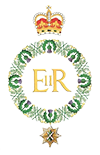Aden and the Radfan- May 1964 to February 1965
During the late 1950's and early 1960's Britain had persuaded most of the twenty sheikhdoms in the hinterland of Aden to join together in the Federation of South Arabia to increase stability in the area. This was opposed by President Nasser of Egypt and Aden's northern neighbour, Yemen. The Egyptians encouraged the tribes in the mountainous hinterland, especially those in the Radfan which lay some sixty miles north of Aden and east of the rough gravel road from Aden to Yemen, to rebel. A military operation was mounted by the British-officered Aden ·Federal Regular Army (FRA) against the dissidents in the Radfan in January 1964, but it was only partially successful and the troops withdrew. In April a larger operation was mounted, including British troops from Aden garrison as well as two FRA battalions. The operation stalled, but reinforcements arrived from the. United Kingdom and in mid-May a further, and this time successful, attempt was made to secure the Radfan. Thereafter it was necessary to. maintain a military presence in the area to prevent a further uprising.
The Battalion emplaned at Lyneham over the period 20 to 22 May. Major Gordon O'Neil-Roe, who was a platoon commander at the time, has personal recollections of his departure.
We staged through the Air Movements Centre in the old prisoner-of-war camp in Devizes, where our Territorial Battalion, the 8/9th Royal Scots, was on its summer camp. The Territorials entertained us royally and this, together with another incident on my way to the departure airfield, made for a memorable send-off. Three members of A Company had committed some minor misdemeanor in the market town of Pewsey some days previously and were due to appear before the Bench Magistrates on the morning of our departure. With our loaded land rover waiting outside I made an impassioned plea for the brave lads about to embark on active service. They were let off lightly and the Chairman, a doughty female in a large hat, and her fellow magistrates came to wave us goodbye as we departed.
The Battalion flew in Britannias and, with refuelling stops at Akrotiri in Cyprus and Bahrain , arrived in Aden after a flight lasting twenty-two hours. Most of the Battalion spent the next ten days based in the tented Aden Transit Camp, described in The Thistle as, 'undoubtedly one of the most depressing and squalid military abodes in existence'. The time was spent acclimatising, drawing equipment and preparing to move up-country. Three days after arrival, however,

South Arabia and the Radfan, 1964-65 (Drawn by Colonel MBH Ashmore CBE)
A Company moved up to the Thumier area to take over as defence company for Headquarters 39 Infantry Brigade Group and the Brigade Administrative Area. In that role it was responsible for manning five picquets sited on high ground which dominated the approaches to the area and it was soon in action. A probing raid by dissidents was experienced on 29 May and two nights later an attack was mounted on three of the picquets. About twenty-five insurgents surrounded a piquet held by Corporal McNicol and five men. A fire-fight ensued, during which 3-inch mortars and a Saladin armoured car supported A Company's small arms fire. The attackers were driven off having sustained two killed and a number wounded. Corporal McNicol was subsequently awarded the Military Medal for his leadership during this incident.
On 9 June the remainder of the Battalion drove north to Thumier and the following day the whole Battalion moved into the Radfan to relieve the 1st Battalion The King's Own Scottish Borderers. The company positions lay to the north-east of Thumier with the dominant heights of 'Gibraltar' and 'Cap Badge ' being occupied by A and B Companies respectively.
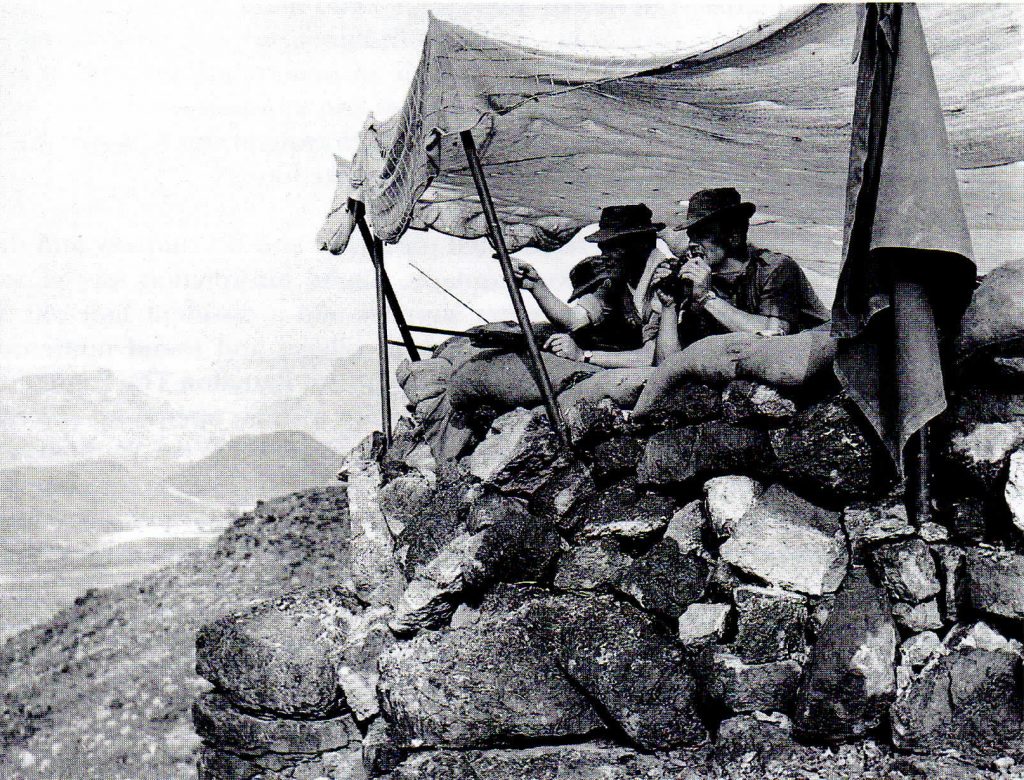
An A Company picquet in the Radfan . Left Corporal Ward, right Sergeant Dickie
C Company moved to a position known as 'November 7' and Battalion Tactical Headquarters and the Reconnaissance Platoon were at 'Paddy's Field '. Both the latter positions were in the Wadi Taym, a large and fertile area surrounded by precipitous mountains, which was a proscribed area and to be denied to tribesmen. The Wadi Taym was vividly described in The Thistle in November 1964.
It was here that much of the earlier fighting had taken place, including the beheading incident after a SAS patrol had been ambushed. Every village is built on a strategic height and every house is a fort with thick walls and fire ports in place of windows. The scene is one of wild, jagged peaks and practically every mountain has sangar positions, fortified caves and hides . Escape tunnels dug right through a mountain are surprisingly frequent. It is ideal country for guerrilla warfare. The rock faces one has to climb over have a disconcerting habit of crumbling and the gentler slopes and wadis are strewn with sharp stones that hurt the feet when marching. The temperature soars to anything up to 128 degrees, but unlike Aden the Radfan has a dry heat and the nights are comparatively cool. Some of the wadis have a surprisingly lush vegetation, but this includes camel thorns capable of penetrating the sole of a boot. Scorpions, centipedes, outsize hornets, flies and mosquitoes abound. At night the air is rent by the howling of piedogs, the braying of donkeys and the numerous baboons moving about look deceptively like locals!
Intensive patrol programmes were adopted on arrival and B Company and the Reconnaissance Platoon soon achieved contacts. Useful information was gained regarding camel train supply routes, water supplies and a dissident hide-out. C Company carried out search operations in several villages and found numerous arms. During Operation Flycatcher D Company of the 3rd Battalion The Parachute Regiment, which was under command of the Battalion for that operation, and the Reconnaissance Platoon flushed out a small group of dissidents in the Wadi Sha'ab Lashaab. There was an exchange of fire. A Forward Air Controller brought down a rocket strike by Hunter aircraft and the dissidents were also subjected to a 3-inch mortar bombardment. Company bases continued to be fired at, often from long range, in the late evening. On every occasions all weapons within range, including 3-inch mortars and armoured cars, returned the fire. After a month the bulk of the Battalion returned to Aden, although C Company was left at Thumier as defence company. The two-week stay in Aden was a change, but certainly not a rest. There was a heavy programme of guards and duties and the strong winds resulted in an almost permanent sand storm raging through the Transit Camp from mid-morning to late afternoon.
No one was sorry to leave Aden and head up-country once more on 17 July to take over positions in the general area of the Wadi Taym. Although the official view was that the Radfan campaign was 'all over bar the shouting' initially life was no different from before; in particular bases were regularly 'shot-up' in the evenings.
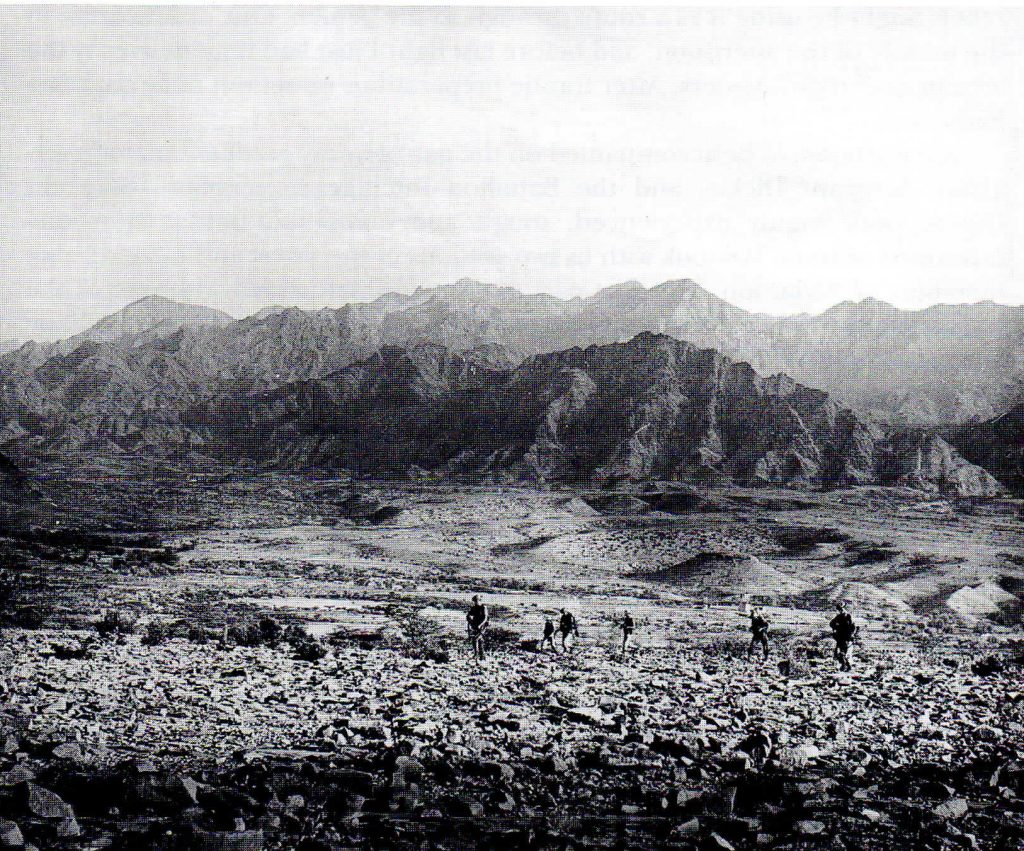
A C Company patrol moving across the floor of the Wadi Taym
Constant patrolling, however , and the laying of ambushes ensured that the dissidents could operate only on the fringes of the Battalion's area, enabling relations to be established with the Halmain tribe who, having been neutral throughout the rebellion, started to take action against some of the dissident gangs. This liaison led to improved intelligence and the deployment of an FRA platoon onto a tactically important feature, previously held by the Halmainis. In late July Lieutenant Gordon O 'Neil-Roe led a deep penetration patrol into the territory of the Ibdali tribe, at the eastern edge of the Radfan, from A Company's base at Blair 's Field.
In an attempt to flush out the last of these tribesmen I was ordered, at very short notice , to take my platoon on a long range patrol into the remotest part of the Radfan mountains where the Wadi Taym joined the Wadi Bana. Aerial reconnaissance had detected activity in the area and it was thought that the rebels might be using it as a route through to the Yemen. Our orders came in the middle of the afternoon, and before last light I just had time to overfly the area in one of our Austers. After frantic preparations we set out once darkness had fallen.
I was fortunate to be accompanied on the patrol by my excellent platoon sergeant, Sergeant Dickie, and the Battalion intelligence sergeant, Sergeant Gillies, both highly experienced, tough and competent senior non-commissioned officers . We took with us two sections of the fittest and most reliable members of 2 Platoon. The first part of our move coincided with one of the regular tropical storms that occurred even at the hottest times of the year. The spectacular lightning and torrential rain helped cover the sound of our movements as we threaded our way across the rough and rocky floor of the Wadi Taym. Before first light we selected, and moved into, a lying-up position in the low ground within striking distance of our objective.
The junction of the Wadis Taym and Bana was overlooked from the south west by a long and precipitous ridge, known only by its military nickname, Yankee Doodle. The plan was that we should scale it by night and establish ourselves in a dominating position from where we could call for artillery support and strikes by fighter ground attack aircraft on any of the Radfanis we could spot.
During a tense and hot day, lying concealed in the wadi bed, we were treated to a very realistic effects demonstration by two Hunter aircraft strafing the area close to our position . Polite enquiries to Company Headquarters revealed that, no, the RAF did not know that we were so far forward, but they would be more careful next time. Encouraged we made preparations for our night climb and, with the help of my two sergeants, we were able to reconnoitre what appeared to be a possible route up Yankee Doodle.
Once darkness fell we moved out and after a stiff climb we emerged on top of the ridge that was our objective. Fortunately we found no opposition and established ourselves relatively securely at the extreme eastern end of the ridge. On the north and east sides we were protected by steep precipices, behind us to the west the ridge stretched back towards our base and only on the southern side were we vulnerable to attack. A bright moonlit night allowed us to prepare our defensive sangar position while admiring the stark and sinister beauty of the craggy peaks that surrounded us. It was to prove lucky that we had this respite.
When dawn came we were in a magnificent position to look down some 2,000 feet into the Wadi Bana and it quickly became apparent that the reports of enemy activity were true and that the area was stiff with tribesmen. I spent the morning chasing groups of Radfanis around the rocks with artillery fire from our direct support battery of 3 RHA and took the opportunity to register defensive fire tasks around our position. At about mid-day we received a welcome re-supply of water, delivered by the RAF in an ancient air sea rescue Whirlwind helicopter. The helicopter was bright yellow in colour and, consequently, if the Radfanis had had any doubts before about our position they certainly knew it thereafter. During the afternoon we started to come under fire from the odd rifleman at extreme range. Due to our commanding position this gave us little concern and we did not respond as the enemy was well beyond the effective range of our weapons. We contented ourselves with the thought that we had to put a stop to any further movement along the Wadi Bana that day.
However, as dusk approached, events changed dramatically. Our southern flank was at the top of a convex slope and this had allowed a strong party of the enemy to creep up to our position and open fire on us from close range. Fortunately the AK47 had not reached that part of the world and the enemy was equipped mostly with bolt-action rifles of the Lee Enfield variety and only one automatic weapon that kept having stoppages. We were able to hold them off but, with limited ammunition and no prospect of re-supply , our situation was not good. It also became apparent that someone was trying to get up onto our position by the route that we had taken on the north side of the position. We discouraged this by dropping grenades over the edge of the precipice and an enthusiastic sergeant from 4 RTR on Blair 's Field jacked up the front of his Saladin armoured car and gave us spectacular, if wildly unpredictable, fire support from his 76 mm gun, firing at well beyond normal maximum range. This was, however , of no assistance in dealing with the main attackers on the other side of the ridge .
It was now fully dark and we had closed in our perimeter and, whilst I did not think we would be overrun, our shortage of ammunition was a concern. I had been calling for artillery support on the defensive fire tasks I had registered in the morning. The dull rumble of the guns firing away down the Wadi Taym , followed shortly by the whoosh of shells passing overhead, and then the flash and crump of their detonation was morale boosting , if not particularly effective. But luck was on our side. Switching fire to one of our closest defensive fire tasks I tried to work out what to do next and then the problem was taken out of my hands. The RHA battery was firing with only five guns, but as the task was pre-registered all the shells landed at once. One shell fell in the valley below us where it was meant to go, but the other four dropped short right on top of our position. Whether they were closer to us or the enemy was hard to tell, but we were well protected in our rock-built sangars whilst the enemy must have been in the open. By the time I had finished telling the Gunners we were dispensing with their services for the time being the enemy fire had ceased and we heard no more from them .
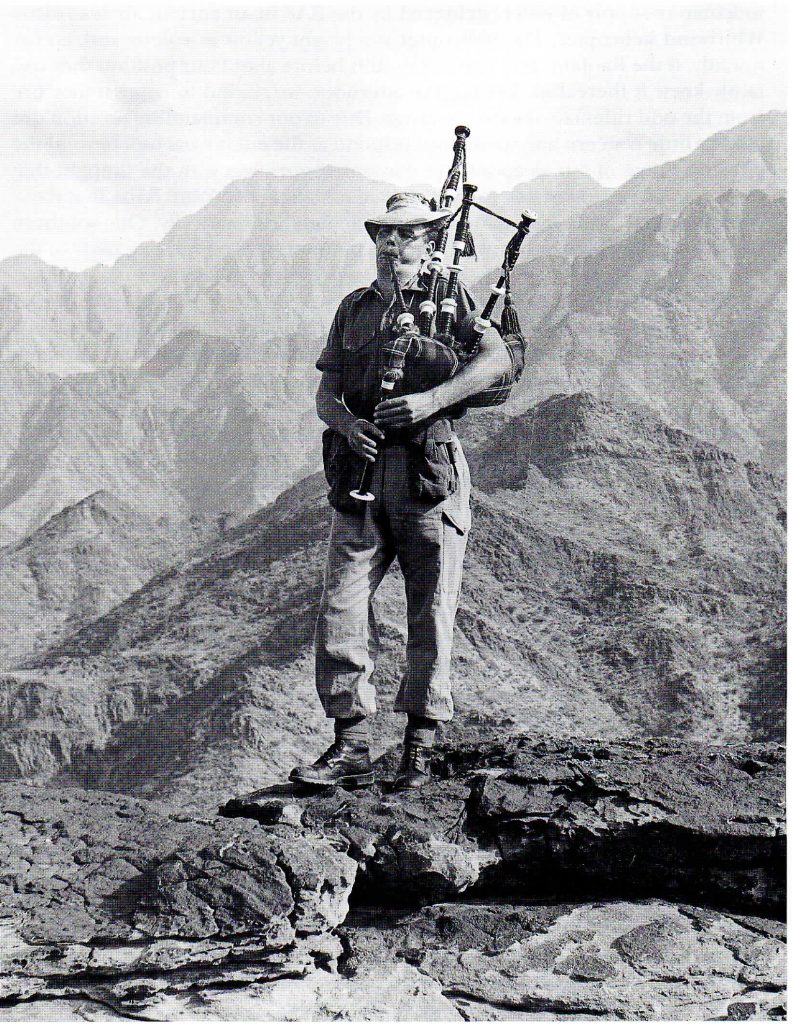
'The Barren Rocks of Aden '. Piper Cowe playing on the Cap Badge feature in the Radfan. The photograph, looking North, was taken by Sergeant Gillies, the Battalion Intelligence Sergeant
We passed a tense night and withdrew back along the ridge at first light the next morning . Before we left we searched the area where the enemy had attacked from, but could find no sign of casualties. We could only presume that four rounds of 105 mm shell fire had frightened them as much as it had us. Having successfully found a route down off the Yankee Doodle feature, 2 Platoon arrived back at Blair 's Field elated and a lot wiser. Waiting for me was a 'mess bill' from 3 RHA for the ammunition expended in helping to extricate us, but with a refund for the stray rounds!
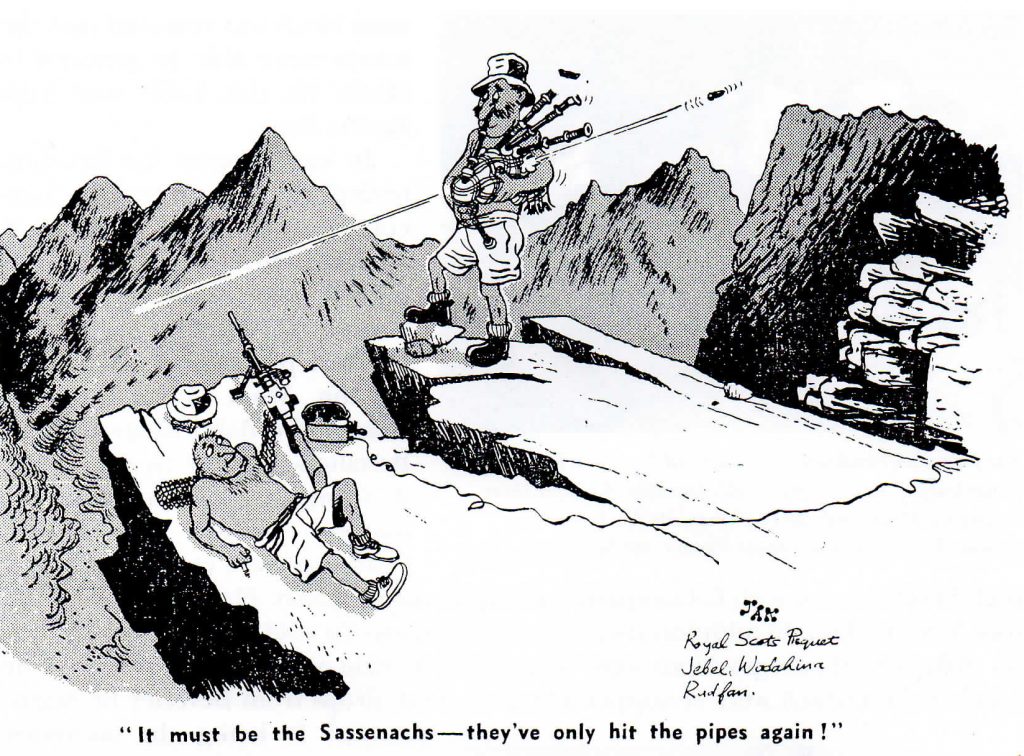
During the same period even the Echelon was called on to conduct operations. Dissidents had ambushed a mixed party of Royal Engineers and Federal National Guard (FNG) on the important Dhala road north of Thumier and set up a road block. To re-open the route a composite force was put together under the Battalion Second-in-Command, Major Bob McCallum MC. This consisted of a large platoon from the Echelon, together with two troops of armoured cars, two platoons of FNG, a section of engineers and a Forward Air Controller. The heights on each side of the road were picquetted on the move northwards and the dissidents withdrew.
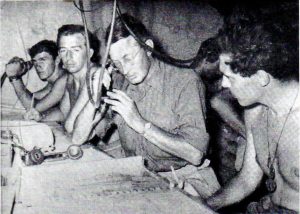
The Battalion Headquarters Command Post in a 'house' on the Hajib feature. Left to right an RA Signaller, Captain (later Brigadier) Mountford , the FOO from 3RHA, Lieutenant Colonel Taylor and Lieutenant Watson, the Intelligence Officer
The road block was removed and the troops were able to proceed to Dhala via the 1,500 foot high Koriba Pass.
In early August the Battalion re-deployed by Belvedere helicopters to take over positions in the Radfan 'Alps', previously held by 45 Commando Royal Marines . The positions were a chain of precipitous peaks south of the Wadi Taym grouped around the Bakri Ridge. A small Battalion Tactical Headquarters, A Company and a composite platoon from Headquarter Company were on the 4,500 foot high Hajib feature with C Company and the Reconnaissance Platoon on the 5,900 foot Jebel Widina. In addition there was a platoon on 'Arnold's Spur' and a section on 'Sababah'. These positions were re-supplied by helicopters apart from those on Jebel Widina which were re-supplied by parachute drops from Beverley or Argosy aircraft. A Belvedere helicopter managed to lift an elderly stripped-down landrover onto the top of the Jebel Widina to help move stores and mortar ammunition. When the time came to redeploy, the vehicle had to be pushed over the edge as it proved impossible to lift off.
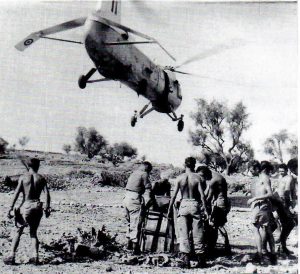
Helicopter re-supply on the Bakri Ridge
It being the monsoon season torrential rain frequently drenched everyone, but at least it was cool. Patrolling was extremely strenuous. It took a day to climb down to establish patrol bases in those wadis where dissidents were operating and another day to climb back up to the bases. A further complication at this time was a change in the rules of engagement. Several tribes which had surrendered were being allowed back into the area and, as everyone was always armed, it was impossible to tell the difference between a dissident and a 'reformed' tribesman .
The policy was that fire could only be returned, thus the dissidents always had the opportunity to fire first. Not a comfortable position.
On 16 August the Battalion, less B Company, returned to Aden. B Company, which had previously been in Brigade reserve at Thumier, from where it had been responsible for patrolling the troublesome Dhala road, moved to Mukeiras a 7,000 foot high hill station on the Yemen border some seventy miles north-east of the Radfan. The month spent based at the Transit Camp was no less busy than the period spent in the Radfan. The situation in Aden was deteriorating and three officers and 116 soldiers were committed day and night on static guards and a variety of internal security duties. In addition to these tasks the Battalion was put on stand-by to move, at short notice, to Mukalla, a port lying some 300 miles east of Aden, where an important RAF emergency landing field was located. It was believed that there might be a terrorist threat there and the Battalion reconnaissance group flew to the airfield in an RAF Beverley, suitably 'disguised' as civilians in desert boots, long khaki socks, shorts, white shirts and trilbies! A plan was made but, although the Battalion's notice to move was reduced to two hours, the operation was cancelled. After all the hard work everyone was relieved to return to the Radfan on 17 September where the Battalion again took over from 45 Commando Royal Marines. The Pipes and Drums enjoyed a very welcome breakfromAden. From mid-September to mid-October 1964 they were in Australia where they participated in the Anglo-Australian Tattoo in Sidney, the first time a formed body of the Regiment had been in Australasia.The old routine was re-established. The dissidents continued to probe the bases' defences by firing into them in the evening and the defenders prided themselves on achieving a swift, accurate and overwhelming response. Offensive action was based on a busy patrol programme which sought to kill dissidents by ambushing them and to deter their operations by overt patrolling to find weapons,
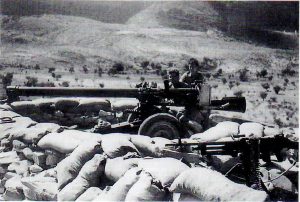
A C Company Mobat, manned by Corporal Turnbull and Private Veitch, with a General Purpose Machine Gun in the Sustained Fire role standing by for 'retaliation fire' on the Table Top feature
ammunition and stores. There were some successes with both these objectives. In the very early hours of 19 September an ambush laid by the Reconnaissance Platoon, led by Lieutenant Francis Gibb, killed a dissident from the Muzahim tribe and later the same day troops of C Company searched caves and houses in the Wadi Falaha and found a rifle, ten rounds of dum-dum type ammunition, food, water, kerosene and boxes of matches. That evening C Company was fired on for about ten minutes by ten to fifteen dissidents and two soldiers were slightly wounded. The dissidents positions were engaged by small arms, 3-inch mortar, Mobat anti-tank gun and artillery fire.
For the next month the patrolling continued, but with less obvious success, and there were fewer incidents of dissidents firing on bases. There was, however, an increase in anti-mine patrols. Although the Battalion suffered no losses from mines, other units had not been so fortunate and throughout the operational area mine clearing, and patrols to deter mine-laying, were of increasing importance. Brigadier (Later Lieutenant General Sir Chandos) Blair, Commander 39 Infantry Brigade, paid £5 from his own pocket, almost a week's pay for a private, to any soldier who found a mine.
The dangers inherent in flying in light aircraft and helicopters over such rugged terrain were a feature of life. On 18 September, however, Major Bob McCallum, the Second-in-Comm and, and Lieutenant Patrick Moore, a Platoon Commander, had a very lucky escape when a Beaver aircraft in which they were flying had to crash land amongst the boulders of the Wadi Rabwa, known as 'Piccadilly Route', linking Thumier to the Wadi Taym. According to one officer who was present in the Radfan there was a 'story', perhaps two, behind this incident.
Bob McCallum organised that he and Patrick Moore should carry out an aerial reconnaissance of a long range patrol route. All went well until they were on their way back when suddenly the engine of the aircraft choked and spluttered before stopping altogether. "Sorry sir, we appear to have run out of fuel", shouted the pilot. There then followed a brilliant piece of flying by the pilot who managed to land the aircraft in the rock-covered bed of the wadi. How he missed hitting anything was a miracle and it was only as the aircraft came to a halt that a rock slightly chipped the propeller. Bob McCallum leaped out of the aircraft and ordered the pilot and Patrick to take up a defensive position. He then asked how many rounds they had. The pilot had an automatic pistol with ten rounds, Patrick a self-loading rifle with fifteen rounds and Bob a .38 inch revolver with five rounds. Bob took command. "Right, Patrick you are to engage the enemy first with your fifteen rounds. When you have run out of ammunition and the enemy are getting close, pilot you are to fire your pistol at them until your rounds are expended. I will then fire two shots at them. "Which of you is the junior?" he then asked. "I am, sir" replied Patrick. "Fine, well I will then shoot you first, then the pilot and keep the last round for myself, as you know what they would do to us if we fell into their hands."
A patrol from A Company duly rescued the three survivors and subsequently the RAF undertook the recovery of what was essentially an undamaged Beaver. A Company secured the area and one of the RAF's large twin-rotor Belvedere helicopters deployed to recover the Beaver.
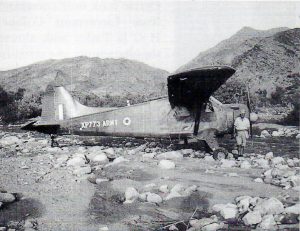
The Beaver aircraft, with Major McCallum, after it had crash- landed in the Wadi Rabwa
The RAF duly hooked up the Beaver and took off with the Beaver slung below. As they flew in a forward motion the Beaver also started to 'fly'. The Belvedere pilot decided that this was jeopardising the safety of his aircraft and jettisoned the Beaver. It spiralled down to the ground and, much to everyone's surprise, exploded in a ball of fire. The subsequent accident investigation team discovered that the pilot had simply failed to correctly switch over his left hand empty fuel tank to his right hand full tank!
On 27 and 28 September Major General Campbell, who was due to assume the Colonelcy of the Regiment on 1 October, visited the Battalion. He toured all the locations and was able to speak to the majority of officers and soldiers.
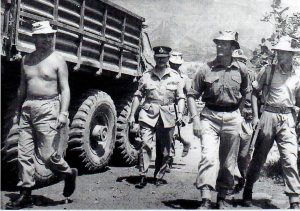
Major General Campbell, Colonel of the Regiment, visiting B Company at Blair's Field. On the left is Company Sergeant Major Tiernan and to the right Major Bewsher and Lieutenant Delacombe. The vehicle is a 'Stalwart ' High Mobility Load Carrier
He was reputed to be the only General Officer to travel down the dangerous track between Blair's Field and Table Top and shortly after he left Blair's Field it came under fire from dissidents. On 21 October, after a busy month, the Battalion returned once more to Aden.
The Battalion's fourth tour of duty in Aden lasted from late October until 10 December. Initially life was relatively quiet. Some sport was arranged and A Company won the inter-company boxing competition.
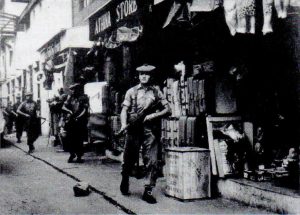
Corporal Brown of A Company leading a foot patrol in Aden Town
On 17 November Lieutenant Colonel A W R Currie took over command from Lieutenant Colonel H D G Taylor and, almost simultaneously, the terrorist situation in Aden town changed for the worse. Thereafter up to two companies at any one time were required to provide mobile patrols, roadblocks and static guards, with the remaining platoons being held in reserve at varying degrees of notice. The Battalion also provided a company-sized detachment at Mukeiras at this time. Because of its situation Mukeiras was always a lively spot and those who served there were certain to be fired on by dissidents at some stage.
Happily, however, these incidents did not result in any casualties. Sadly on 31 October 1964 Private J Bonnes was knocked down and killed by a taxi on the Causeway in Aden. He was the only Royal Scot to die during the tour.
During this period the Battalion provided a platoon-sized garrison on Perim Island at the mouth of the Red Sea where it was responsible for guarding the radio station. Travel to and from Perim Island was by a small open vessel known as a Ramp Powered Lighter and, as a consequence of rough seas, was usually hazardous. Once the passage had been completed, however, the garrison was able to make good use of opportunities for swimming and fishing.
On 11 December 1964 the Battalion moved back up-country for its fourth and final tour of duty in the Radfan. On this occasion A and C Companies covered the whole of the Wadi Taym and Danaba Basin areas while Battalion Headquarters, Headquarter Company and B Company remained at Thumier. This widespread deployment was a consequence of a decision to withdraw Headquarters 24 Infantry Brigade Group, who had moved to Aden from Kenya, and replace it with elements of the FRA. Once again operations resumed their normal pattern as this extract from The Thistle makes clear.
Immediately after arrival all companies set-to with a will to dominate their areas by vigorous patrolling , the bias being on the anti-minelayer type of patrol and ambushes.
C Company were fired on with automatic rifle fire at Blair's Field the first night up on 11 December. One dissident was killed and a couple wounded by Major Wilson Smith's retaliatory artillery fire on this night. Again an auspicious start.
In the following period C Company continued to be sniped at and subjected to automatic fire fairly frequently, mainly at dusk.
The pattern was the same elsewhere. At Thumier the opposition first fired a blindicide bazooka at the political officer's house and later shot up Delta picquet twice with rifle and automatic fire and once also with a bazooka.
Charlie picquet at Thumier also had a few shots near it. The FRA reported that the latter came from an Arab wedding in the Wadi Misrah, but the occupants of the picquet flatly disagreed. The dissidents now turned their attention to A Company in the Danaba Basin. Here Major Robert Sandeman had his Company HQ and the Pipes and Drums at the Monk's Field position and his mortar section acting as a picquet at the water point.
On 20 December the Halmain tribal picquet, which usually guarded the northern approach, stated they would not be able to operate that night owing to 'sickness'.
During the night the dissidents launched a well coordinated attack on Monk's Field and the water picquet. Both were attacked by machine-gun and rifle fire, and a blindicide was projected at the water picquet.
Monk's Field was, in addition, subjected to bombardment by two-inch mortar fire and three bombs landed very close to or in the position. Piper Brown was wounded by shrapnel and Piper Mitchell was slightly wounded. Unfortunate though this was we had been very lucky. CSM Cannan had only that afternoon moved a tent from the very spot where one bomb had landed in order to spread the defenders more. Had he not done this the bomb would have landed on six sleeping Royal Scots.
On Christmas Day C Company were just finishing a large Christmas lunch when they came under heavy automatic and rifle fire from four directions. The administrative area, including the cookhouse, got the worst of this pasting and CSM Simson was grazed by a bullet on his left elbow. Sergeant Gilbert also had a close shave and what had been a festive scene now became a mad scramble for stand-to positions.
Despite these shooting incidents the most serious threat came from mines. For that reason vehicle movement was kept to a minimum and all vehicles were fitted with armour plate and sandbags to minimise the effects of blast. Nevertheless the inevitable re-supply convoys were appropriately nicknamed the 'Russian Roulette Run'. By the end of 1964 sixty-six vehicles had been blown up on mines in the Radfan and although, overall, the Battalion was lucky, it did not escape without casualties. On 11 December A Company's CQMS was driving along Piccadilly Route towards his company's position when his three-ton vehicle hit a Mark VII mine.
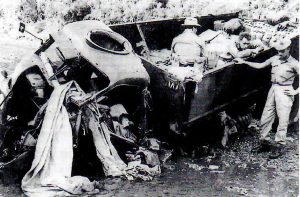
The A Company three-tonner after it had hit a mine near the Monks Field water point
The vehicle was flung twenty feet and CQMS Barton and Privates Lorimer and Canyon were injured. The following day another A Company three-tonner hit a Mark V mine near the Monk's Field water point injuring the driver, Private Walker. Happily the injured made rapid and complete recovenes.
On 29 December, after a short but eventful tour up-country, the Battalion left the arid, yet majestic, wilderness of the Radfan for the last time and returned to Aden. New Year was celebrated in traditional style and everyone was delighted to hear that the RSM, WOl Les Skinner, had been awarded the MBE in the New Year's Honours List. After a short break the preparations for returning home had to be combined with the usual security operations in Aden. In addition to normal duties two cordon and search operations were carried out during which a number of arms and a sack of grenades were found. Other day-to-day operations resulted in a number of arrests and wanted cars being impounded. In 1964 there were thirty-six security incidents in Aden town but, during 1965, that figure rose to 286. The advance party left for the United Kingdom on 23 January 1965 and the main body followed in mid-February. Everyone was pleased to be going home but, equally, everyone had enjoyed and benefited from their spell on operations. The Battalion was supremely fit and all ranks, especially the junior commanders , had gained invaluable experience.
Return to Tidworth.
On arrival back at Tidworth the Battalion proceeded on six weeks well-earned leave. When it returned its first priority was to send as many officers and NCO's as could be spared on coruses to make up for those vacancies which had been lost while overseas. Nethertheless the Battalion was soon involved in a busy training schedule which included air portability, infantry co-operation and helicopter-borne assualts. Part of A Company's 'training' included the unusual experience of providing 'extras', along with some tanks from the 3rd Royal Tank Regiment, in the making of the film Help on Salisbury Plain with the pop-group The Beatles. Several of the jocks managed to get the Group to autograph their Tam O' Shanters but later, sadly for them today, they put them through their washing machines!
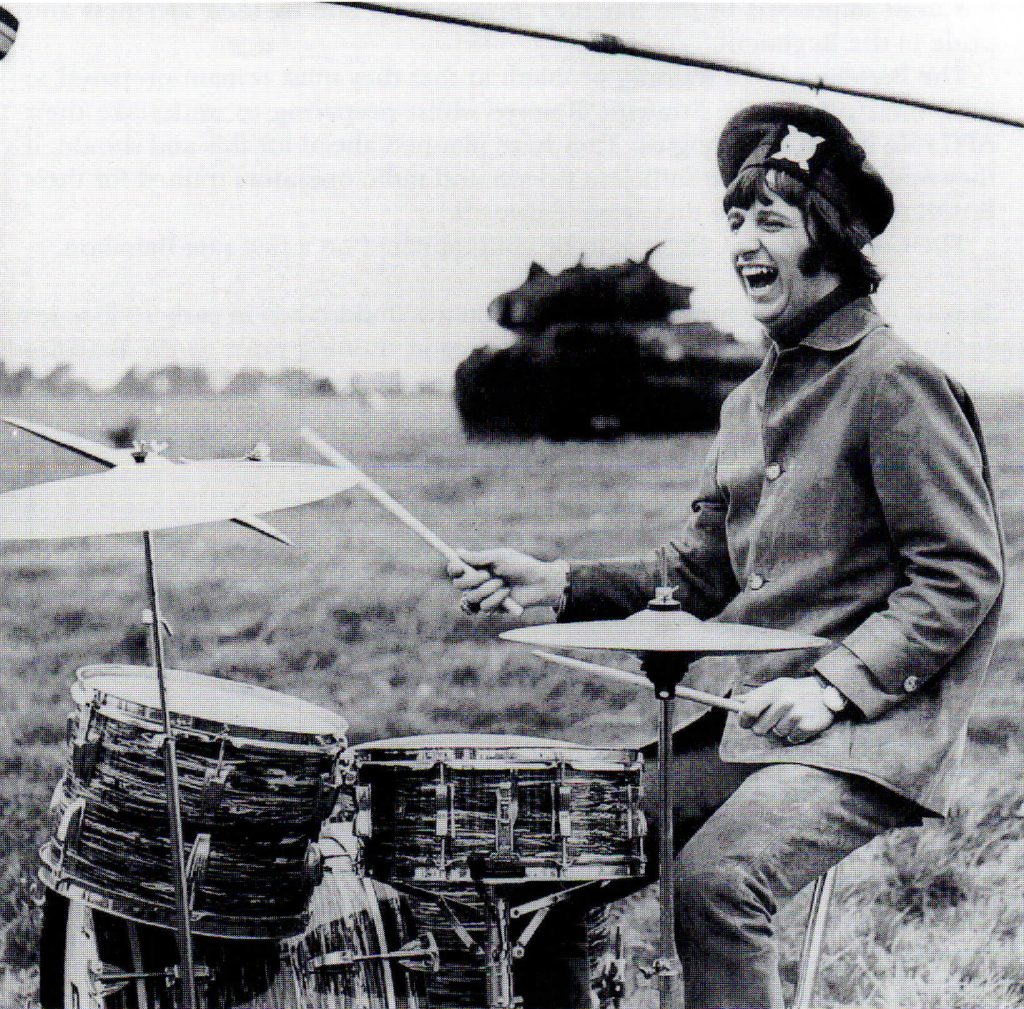
Ringo Starr of The Beatles wearing a Tam o' Shanter during the filming of 'Help'
